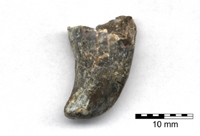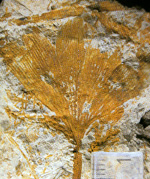Other Winton Formation fossils
The Elliot site has so far produced much more than sauropod bones. Indeed, the fossils that have been found in association with Elliot and Mary's bones are helping us piece together an accurate picture of the ancient world these gentle giants inhabited.
OTHER VERTEBRATE FOSSILS
Theropod dinosaurs
One of the highlights of the 2002 Elliot dig was the discovery of tooth from a theropod ? a two-legged, meat-eating dinosaur. The crown of the tooth is about 2 centimetres long. The root, which has broken off, would have been about the same length, making the complete tooth about 4 centimetres long. The fact that the root has broken off indicates that the tooth was probably shed while the animal was still alive. Just like crocodilians, theropods continually replaced their teeth throughout life, and new teeth quickly grew in the place of those that were lost during feeding or combat. In the case of this theropod, it's possible that the tooth may have broken off while the animal was feeding on Elliot's carcass. Alternatively, it may simply have just washed in from somewhere else. The animal it came from was probably similar to the theropods that left their tracks in the stampede at Lark Quarry Conservation Park, almost 200 kilometres away.
Crocodilians and turtles
Careful sorting of the sediment associated with the sauropod bones has began to produce the remains of small crocodilians and perhaps even turtles. Most of the crocodilian fossils recovered so far are teeth. Similar to the theropod tooth, these are also broken off at the base, indicating that they may also have been lost while the crocodilians were scavenging the sauropod carcass.
Visit the lab to see how these fossils are found
Recent publications
Salisbury, S. W. 2003b. Theropod teeth from the Lower Cretaceous Winton Formation, central-western Queensland, Australia. Conference on Australian Vertebrate Evolution, Palaeontology, and Systematics, Queensland Museum, Brisbane, July 7-11 2003. Abstracts.
Salisbury, S. W. 2005. A new vertebrate assemblage from the mid-Cretaceous (Albian-Cenomanian) Winton Formation, central-western Queensland. 10th Conference on Australian Vertebrate Evolution, Palaeontology and Systematics. Naracoorte Caves World Heritage Area, South Australia, 29 March ? 2 April 2005. Abstracts.
INVERTEBRATES
Arthropods

The siltstone in which Elliot and Mary's bones are preserved has also produced the fossilised remains of tiny insects. Dr Alex Cook from the Queensland Museum found the first of these during the 2002 dig: the wing case of a tiny beetle. Since Alex's discovery, Dave and Judy have found several more insect fossils, including the wing of what could be a very unusual dragonfly. In 2003, Scott Hocknull found part of the wing of a damselfly.

Molluscs
At least two types of small, freshwater bivalves or mussels have been found at the Elliot site. According to Dr Alex Cook and Scott Hocknull, the occurrence of one of these mussels (Prohyria macrimichaeli) indicates the presence of a slow-flowing river.
Plants
Plant fossils abound at the Elliot site. Most are represented by impressions, but on the odd occasion we have found natural moulds and casts. The surface of the blacksoil on the surrounding Mitchell grass downs is also littered with pieces of petrified wood.

These plant fossils help paint a vivid picture of the world that Elliot and Mary inhabited. Between the numerous sandy channels and mudflats of the lower-lying river plains were stands of towering araucaria pines and sequoias. In some areas, the open forest probably gave way to shady groves of ginkgos and Antarctic beech, below which was a lush understorey of tree ferns. In spring it's likely that the air would have been tinged with the soft fragrance of lofty magnolias.

